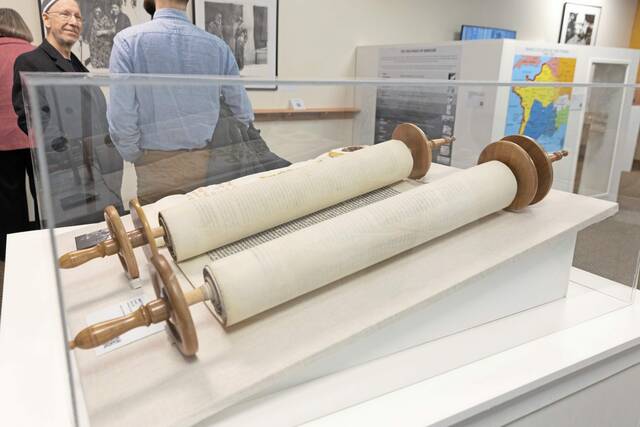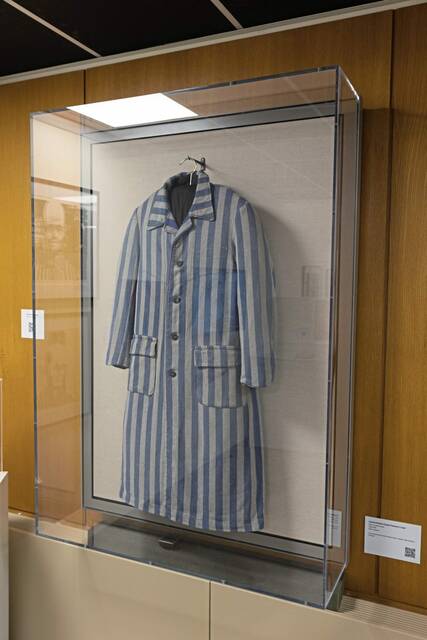Holocaust Center's 'Revolving Doors' exhibit focuses on persistent antisemitism
It was the Spanish and American 20th century philosopher George Santayana who said, “Those who cannot remember the past are condemned to repeat it.”
A new exhibit presenting a curated selection of artwork and artifacts from the collection of the Holocaust Center of Pittsburgh is designed to drive that very point home about the Holocaust and its connection to today’s virulent antisemitism.
The Holocaust was the systematic murders of about 6 million European Jews carried out by Nazi Germany and its collaborators before and during World War II.
The “Revolving Doors” exhibit opened two weeks ago inside the Jennie King Mellon Library at Chatham University, the Holocaust Center’s academic home. It’s open from noon to 3 p.m. Mondays through Fridays. The room housing the exhibit is not very big, but there is a lot happening within it.
Lauren Bairnsfather, executive director of the Holocaust Center of Pittsburgh, said there are two threads running through the exhibit.
“I don’t know of any other exhibit that has attempted this, but one thread is about antisemitism and its persistence across time and the other is about assimilation,” Bairnsfather said. “So, we have an American Jewish story in here. We have the Holocaust through artifacts and we end with Oct. 27, 2018.”
It includes artists’ responses to the attack on three congregations in the Tree of Life building on Oct. 27, 2018, paying tribute to the 11 victims while honoring survivors and their resilience.
The name of the exhibit, “Revolving Doors,” is inspired by a series of collages created by artist Man Ray in 1916-17. One of the pieces from that series is on display in the exhibit. “Revolving Doors” refers to a situation where solutions to problems last for a short time only, and then the same problems happen again.
It ties in with the Holocaust Center’s mission to recognize patterns of the past and connect the horrors of the Holocaust and antisemitism with injustices happening today and recommend ways to break cycles of prejudice and persecution.
School trips were scheduled to begin in February. Though Bairnsfather said the exhibit is pretty conceptual for students, the staff has been working on ways of making it something that students can understand and connect to.
“When I started almost eight years ago, students and even some young adults, I didn’t feel, were connecting with artifacts,” Bairnsfather said. “But now, increasingly, that Gen Z thing, they want to see the authentic object and the things that are real because everything is virtual. They want authenticity.”
And there is plenty of authenticity to be found in this exhibit, including many artifacts that came from France, one of the countries to which Nazi influence spread.
“In order to understand how you get to 6 million (Jews murdered) in Europe, you have to understand Nazi expansion,” Bairnsfather explained as she led a visitor to a display of framed broadsheets, including one with French lyrics of a song called “The Wandering Jew.”
“These were mass produced in France, and the point is that there was this underlying antisemitism in French culture that was accepted. And it was like that in parts of Germany as well, which explains how the Nazis were able to be successful with their antisemitic beliefs and platform — because people felt that way,” she said.
Also on display is an authentic striped prison-type concentration camp uniform. There were different patches on the uniforms depending on who wore them, including a Jewish star and a pink triangle that gay men were made to wear.
There are also line of demarcation signs pointing out, in German and French, areas Jews were not allowed to enter.
More uplifting artifacts include a tree made of birch by the daughter of one of the first responders the day of the Tree of Life shooting and a Torah that Bairnsfather calls “the hope in our exhibit,” which survived Kristallnacht, a night that got its name from all of the broken glass leftover from 48 hours of death and destruction of Jewish-owned businesses, homes and synagogues in Germany on Nov. 9-10, 1938.
Eventually, it was donated to the Holocaust Center.
“Nazi Germany was a bizarre ethical universe that we have a lot of trouble relating to now. But upon reflection, violent extremists today also live in a bizarre ethical universe. I marvel at the layers of understanding we continue to derive from our knowledge of the Holocaust,” Bairnsfather said.
The Holocaust Center plans to add weekend hours to the exhibit schedule.
Remove the ads from your TribLIVE reading experience but still support the journalists who create the content with TribLIVE Ad-Free.



